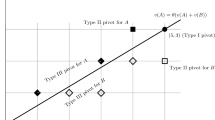Abstract
For the case of strict preferences, a measure of a voter’s average power in a dictatorial social welfare function is defined making the dictator never have more average power than three voters and, as the number of voters grows, making the dictator average power converge to the average power of two voters. This result suggests, as those in Tangian (2004), that dictatorial social welfare functions might not be as undesirable aggregation rules as traditionally held.
Similar content being viewed by others
References
Arrow, K. (1963). Social choice and individual values (2nd edn). New York: Wiley.
Brualdi, R.A. (1999). Introductory combinatorics (3rd edn). Upper Saddle River, New Jersey: Prentice Hall.
Tangian, A. (2003). Combinatorial and probabilistic investigation of Arrow’s paradox, Diskussionsbeitrag Nr. 336 des Fachbereichs Wirtschaftswissenschaft der FernUniversität Hagen, Hagen. Retrieved from http://www.fernuni-hagen.de/wiwi/forschung/veroeffentlichungen/2003.shtml.
Tangian, A. (2004). How dictatorial are Arrow’s dictators? (Paper presented at the 7th International Meeting of the Society for Social Choice and Welfare, Osaka).
Author information
Authors and Affiliations
Corresponding author
Rights and permissions
About this article
Cite this article
Quesada, A. 1 dictator = 2 voters. Public Choice 130, 395–400 (2007). https://doi.org/10.1007/s11127-006-9094-0
Received:
Accepted:
Published:
Issue Date:
DOI: https://doi.org/10.1007/s11127-006-9094-0




